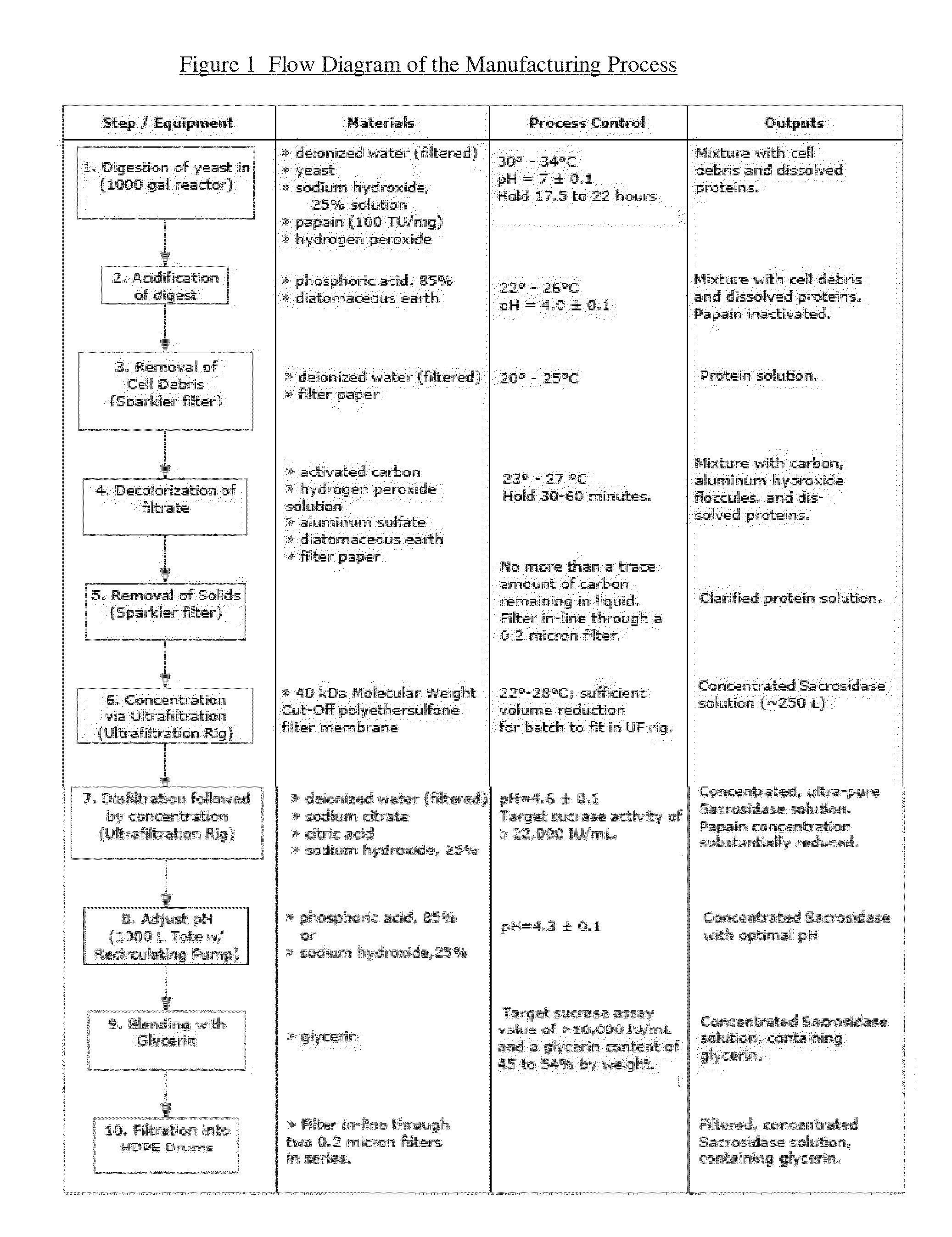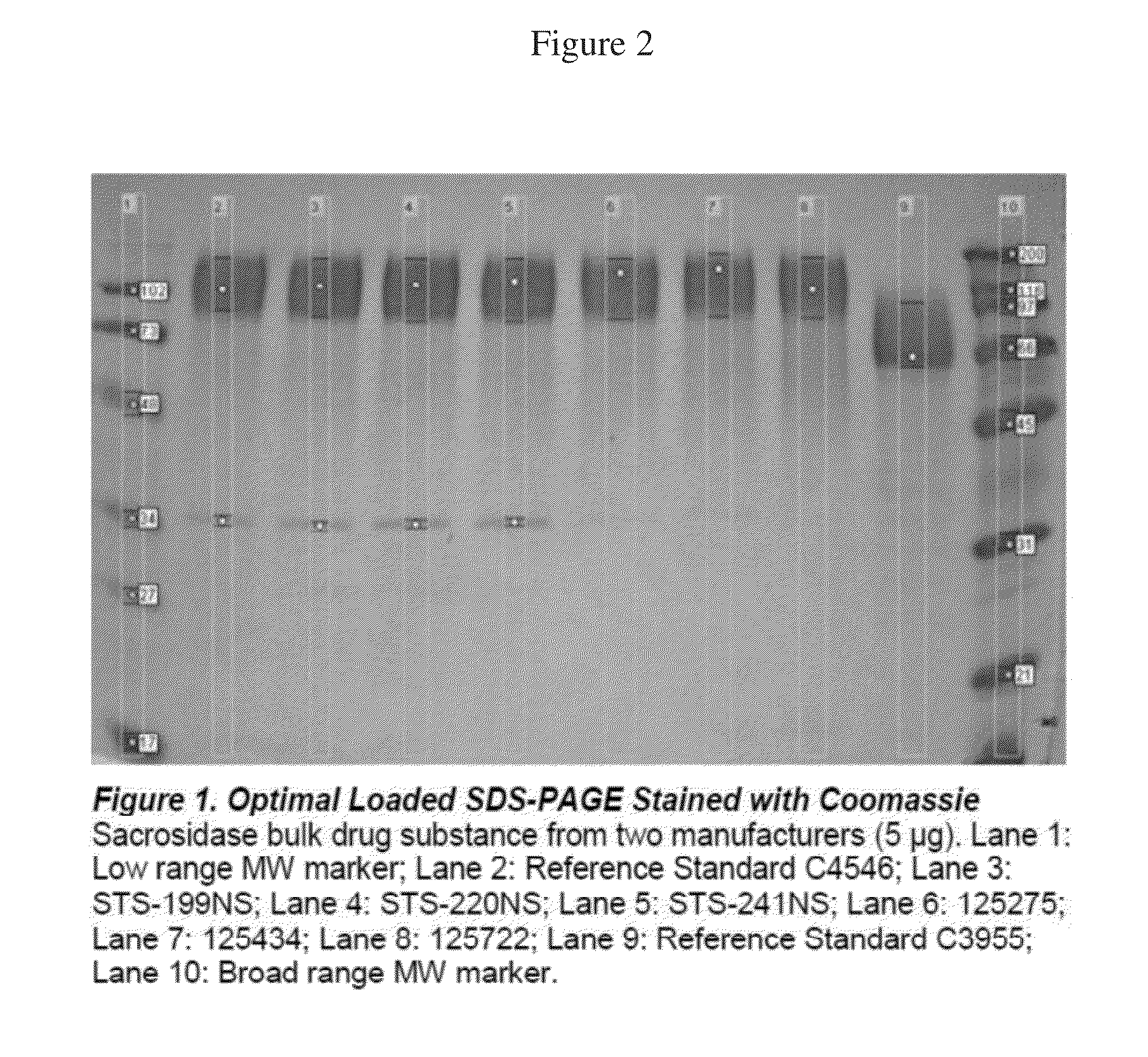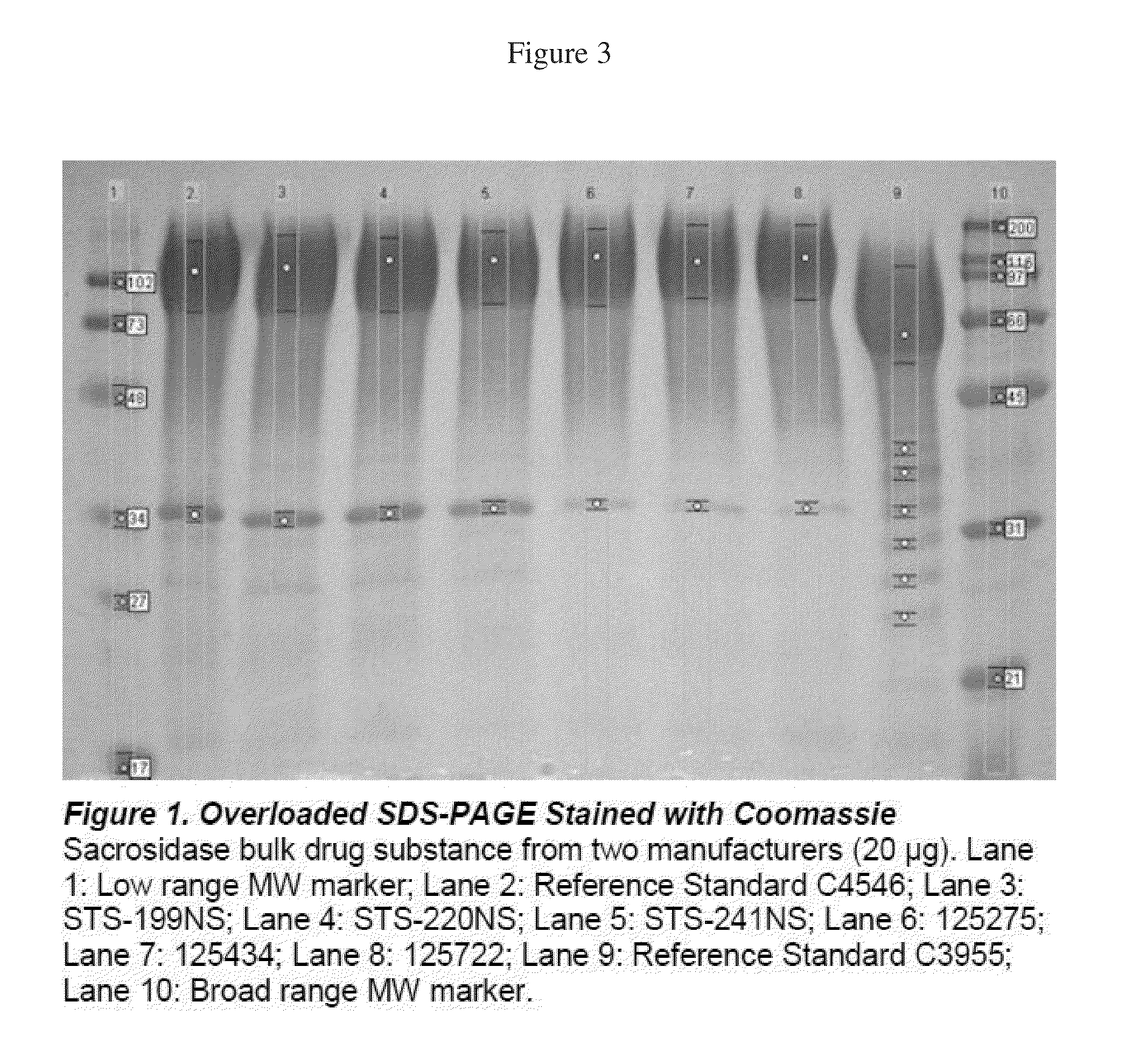Ultrapure hypoallergenic solutions of sacrosidase
a technology of sacrosidase and hypoallergenic solutions, which is applied in the direction of enzymology, drug compositions, peptide/protein ingredients, etc., can solve the problems of affecting the normal function of the body, so as to achieve the effect of improving the organolepsia
- Summary
- Abstract
- Description
- Claims
- Application Information
AI Technical Summary
Benefits of technology
Problems solved by technology
Method used
Image
Examples
example 1
Manufacturing Process for Ultrapure Sacrosidase
[0036]Deionized water (1700 kg) is charged to a 1000 gallon reactor and heated to 32±2° C. at which time Saccharomyces cerevisiae yeast (360 kg) is added and the slurry is mixed for 20-30 min. The pH is checked and if it is found to be below 6.9, the pH is adjusted using a 25% sodium hydroxide solution until the pH is 7.0±0.1.
[0037]Papain (3.4 kg) 100 TU / mg is added followed by hydrogen peroxide (35%, 2.8 kg). The slurry is stirred at 32±2° C. for the next 17.5 to 20 h; after every 3.5-4 h the pH is adjusted to 7.0±0.1 and hydrogen peroxide (34%, 2.8 kg each portion, 11.2 kg total) is added.
[0038]Once the 17.5-20 hours of mixing is complete the mixture is cooled to between 22° C. and 26° C. at which point 25 kg of 85% phosphoric acid is added over a 20-30 min period. The pH of the slurry is checked and the pH is further adjusted to 4.0±0.1 by addition of 85% phosphoric acid.
[0039]Diatomaceous earth (Celpure® S 1000, 210 kg) is added to ...
example 2
Coomassie Blue Stained Reduced SDS-PAGE Gel with Densitometry—Optimal Load
[0045]The gel shown in FIG. 2 is a Coomassie stained, reduced SDS-PAGE comparing 3 lots of a prior sacrosidase manufacturer (Lanes 3, 4, 5) that was manufactured with an older manufacturing process, with 3 lots of sacrosidase (Lanes 6, 7, 8) manufactured using the new ultra-pure hypoallergenic manufacturing process. Reference standard C4546 is the reference standard currently in use and was produced from the older process. Reference standard C3955 is an older-yet reference standard from the original Sacrosidase manufacturer.
[0046]The densitometry scan of this optimally loaded SDS-PAGE gel is shown below (Table 1). These results clearly show that the sacrosidase manufactured using the new process is ultrapure with no detectable protein impurities. The cGMP validation of this method established a limit of detection of less than 0.1 micrograms.
TABLE 1LaneBandBandSample TypeLot NumberNo.No.Volume% DensityReference...
example 3
Coomassie Stained Reduced SDS-PAGE Gel with Densitometry—Overloaded Gel
[0047]In a second protocol reduced SDS-PAGE gels were overloaded with 20 μg of protein (FIG. 3). In the Coomassie stained gels, a small impurity band is visible in the present sacrosidase drug substance, but the absolute purity of the sacrosidase of the invention (˜97%, Lanes 6, 7, 8) is still superior to the older sacrosidase (˜90%, Lanes 3, 4, 5). Table 2 summarizes the information from this gel.
TABLE 2ProteinSampleSampleQtyLaneBandBandBandBand%TypeLot(μg)No.No.rfVolumeSumDensityReferenceC4546202.1.0.1514419486790.80Standard2.2.0.5614489.20OldSTS-203.1.0.1455063558890.60Process199NS3.2.0.5685259.40OldSTS-204.1.0.1325460596991.47Process220NS4.2.0.5595098.53OldSTS-155.1.0.1324577500391.49Process241NS5.2.0.5504268.51New125275156.1.0.1265157529297.45Process6.2.0.5421352.55New125434157.1.0.1344820493697.65Process7.2.0.5461162.35New125722158.1.0.1284832493197.99Process8.2.0.550992.01ReferenceC3955159.1.0.257564063268...
PUM
| Property | Measurement | Unit |
|---|---|---|
| concentration | aaaaa | aaaaa |
| band volume ratio | aaaaa | aaaaa |
| volume ratio | aaaaa | aaaaa |
Abstract
Description
Claims
Application Information
 Login to View More
Login to View More - R&D
- Intellectual Property
- Life Sciences
- Materials
- Tech Scout
- Unparalleled Data Quality
- Higher Quality Content
- 60% Fewer Hallucinations
Browse by: Latest US Patents, China's latest patents, Technical Efficacy Thesaurus, Application Domain, Technology Topic, Popular Technical Reports.
© 2025 PatSnap. All rights reserved.Legal|Privacy policy|Modern Slavery Act Transparency Statement|Sitemap|About US| Contact US: help@patsnap.com



